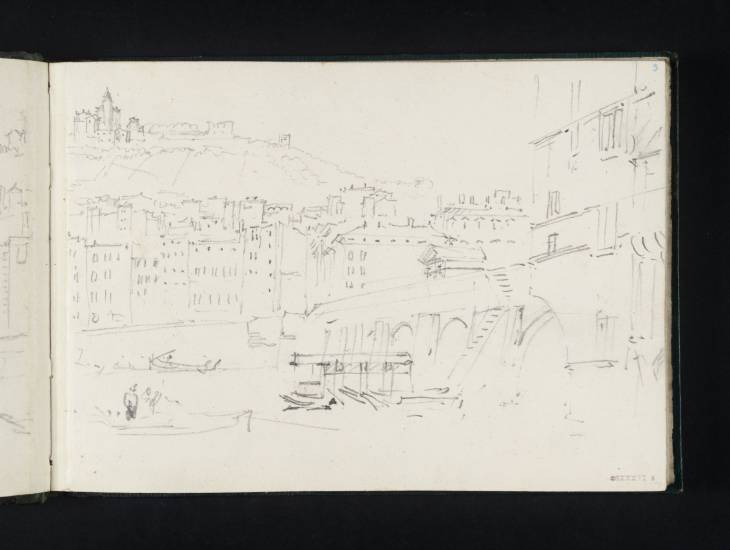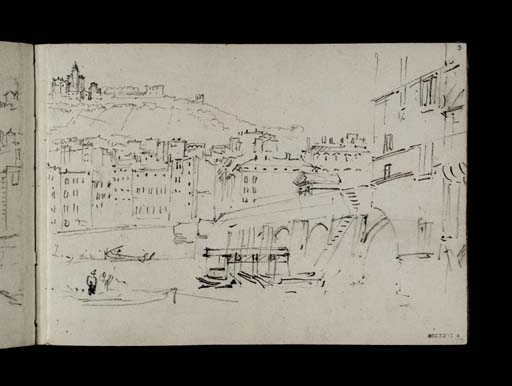Joseph Mallord William Turner The Pont du Change, Lyon 1828
Image 1 of 2
Joseph Mallord William Turner,
The Pont du Change, Lyon
1828
Folio 3 Recto:
The Pont du Change, Lyon 1828
D21769
Turner Bequest CCXXXVI 3
Turner Bequest CCXXXVI 3
Pencil on white wove paper, 125 x 171 mm
Inscribed in blue ink by John Ruskin ‘3’ top right and ‘173’ bottom right
Stamped in black ‘CCXXXVI 3’ bottom right
Inscribed in blue ink by John Ruskin ‘3’ top right and ‘173’ bottom right
Stamped in black ‘CCXXXVI 3’ bottom right
Accepted by the nation as part of the Turner Bequest 1856
References
1909
A.J. Finberg, A Complete Inventory of the Drawings of the Turner Bequest, London 1909, vol.II, p.723, CCXXXVI 3, as ‘Do.’ (i.e. ditto: ‘Town, with river and bridges.’).
1983
John Gage, Jerrold Ziff, Nicholas Alfrey and others, J.M.W. Turner, à l’occasion du cinquantième anniversaire du British Council, exhibition catalogue, Galeries nationales du Grand Palais, Paris 1983, p.109 under no.43.
This panoramic study of riverside buildings and a bridge forms part of a wider vista, part of which continues onto folio 2 verso (D21768) opposite. Finberg’s 1909 Inventory of the Bequest assigned it the generic title Town, with river and bridges, but was unable to pinpoint a more precise location.1 More recently, the geographer and Turner researcher Roland Courtot has identified the subject as the French city of Lyon.2 From his vantage point on the left bank of the River Saône, looking west, Turner sketched the Pont du Change, the bridge connecting the area known as the Presqu’île, to the right, and the old town across the river, overlooked by the Fourvière hill. The Pont du Change sketched here by Turner is the eleventh-century seven-arched stone bridge. It was replaced in the 1840s and sustained later damage during the Second World War, before being finally demolished in 1974.3 As Courtot noted, a feature of Turner’s depiction is the staircase that descends from the bridge to the river, allowing passengers to board a boat.4 Two boats are shown to the left.
Together with folios 1 verso and 2 recto (D21766–D21767), which also depict Lyon, this sketch falls outside the geographical itinerary embodied by this Viterbo and Ronciglione sketchbook. Chronologically, these depictions of Lyon are also noteworthy as either the earliest or the latest sketches of Turner’s 1828–9 tour of France and Italy; it is unclear whether he sketched them on the outward or return leg of his journey.
Turner first sketched Lyon in 1802, and later in 1819–20 during his first major tour of Italy: for a list of relevant works, see Nicola Moorby’s entry in the Paris, France, Savoy 2 sketchbook of 1819 (Tate D14071; Turner Bequest CLXXIII 51).
Hannah Kaspar
December 2024
Roland Courtot, ‘12. Vers Rome: “Carnet de Viterbe et Ronciglione” (TB CCXXXVI)’, Carnets de voyage de Turner, accessed 15 July 2024, https://carnetswt.hypotheses.org/2312 .
‘Bridges of Lyon’, Wikipedia, accessed 2 August 2024, https://en.wikipedia.org/wiki/Bridges_of_Lyon .
How to cite
Hannah Kaspar, ‘The Pont du Change, Lyon 1828’, catalogue entry, December 2024, in David Blayney Brown (ed.), J.M.W. Turner: Sketchbooks, Drawings and Watercolours, Tate Research Publication, February 2025, https://www


